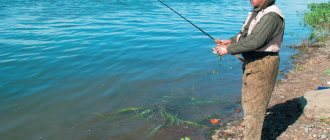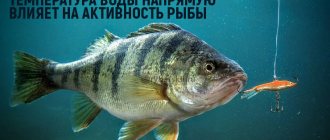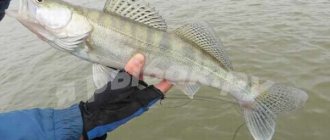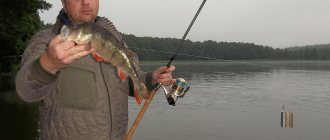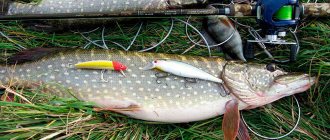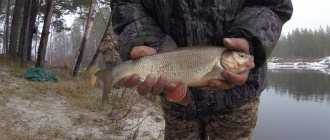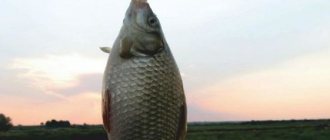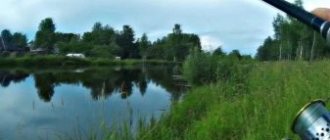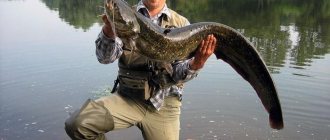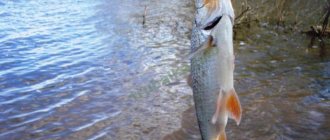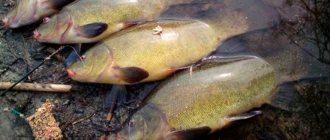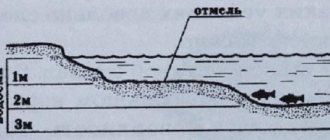It works?
Faced with bites from pike perch and breaks of thin leashes of bream tackle, it was decided to start catching the predator purposefully, and with a feeder. No reasons were found that would prevent this: the fish attacks the bait *predator*, but it doesn’t really care about the rod. The thin tip reflects all movements, including the movement of the fry and its restlessness during an attack by a predator. A higher bite/hook performance was also observed compared to conventional telescopic and spinning rods.
Catching predatory fish on a feeder
> How to catch > Donka / feeder > Catching predatory fish on a feeder
Many anglers know very well what a feeder is and how to use it. Fishing with feeder gear is mainly aimed at white fish. This gear involves targeted frequent feeding of one point, which has the goal of keeping the fish in the zone of influence of the bait.
Many feeder lovers have probably encountered a situation where a predator, pike perch or pike, came across the feeder while fishing for white fish. Most often this happens in cases where a lot of small fish, bleak, silver bream or roach come to the bait. It is quite natural that it attracts predatory fish, which follow the small things. But if perch and pike perch that grab the bait can almost always be caught, then with pike the situation is different; usually it simply cuts the lead and calmly swims away.
Therefore, some fishermen began to adapt the feeder for catching predators
. For this, a combined leash is made. So, approximately the first 30 cm of the equipment is left standard, but the fishing line is used thicker than usual 0.25-0.27 mm, and at the very end of the equipment a “soft” tungsten leash is mounted, the length of which can be 25-30 cm. The leash is equipped with a double or tee, less often with a single hook. The main bait is quite naturally live bait.
Predatory feeder
has a significant advantage over a float rod designed for live bait fishing. This advantage lies in the fact that it is possible to attach bait with live bait at any time and anywhere in the reservoir.
In the bottom layer of a reservoir, it is quite possible to catch even a trophy-sized pike using a feeder. A feeder with bait attracts small fish, which soon attracts pike. And in most cases, pike choose live bait to attack. After all, live bait does not move like an ordinary fish, especially only within the limits that the leash allows it. Some fishermen believe that it will not be possible to purposefully catch pike using a predatory feeder. However, this is not at all true. If for some reason the peaceful fish do not bite or small things interfere greatly, it is quite easy to change the equipment and thus make a feeder for catching predatory fish
.
However, you can use two feeders at once, one to catch predators, the other to catch peaceful fish. At the same time, there is no need to move long distances along the shore in search of a predator; sooner or later it will approach. However, if you assume that your prey could be a trophy-sized pike, which means a large and strong predator that cannot be taken so easily without a fight. You need a reliable rod and equipment that can withstand the jerks of a pike when fishing.
If there is little pike in the reservoir and perch predominates there, it would be advisable to prepare feeder gear for catching perch. That is, change the leashes to thinner ones and the hooks to smaller ones. As you know, perch is very voracious, it fattens all year round and often grabs feeder baits. And if instead of a worm, bloodworm or maggot you use small gudgeon or bleak. Then there is a high probability that you will hook a real trophy humpback whale. For this reason, the predatory feeder
A very effective means of catching perch.
Typically, schools of perch always hang around in places where a variety of white fish feed, so the feeder is a great attractor for striped predators. To catch perch, the feeder is usually equipped with a leash 45-50 cm long, a sliding sinker and a float. If fishing for perch on a feeder
It is assumed at sufficiently large depths, then it is more practical to use a sliding float. If you intend to cast over a short distance, where the depth is shallow, then it is better to equip the tackle with a blind float.
The setting of the float itself also depends on the depth of fishing; besides, the place where it is attached is largely determined by the presence and strength of the current. It is recommended that before tying the float to a place, you should first make a test cast without bait and watch the float for a while. Usually a perch caught on a hook behaves very actively, it resists and, depending on its size, can offer very stubborn resistance. When catching a predator, the fishing line should not be fixed, as in this case there is a high probability of breakage. If perch is caught using animal bait (worms, insect larvae, bloodworms), some fishermen use small feeders, which are filled with the same bait that is mixed with river soil on the hook.
Catching a predator on a feeder
, has its own characteristics. The rod should be sensitive to even weak bites, and it is very important that it be equipped with a thin tip. Or you simply risk not noticing light perch bites. You can also use a device such as a “helicopter” to catch perch. This equipment is used if you need to play along with bait when the feeder is stationary.
Even in the darkest times, you can catch small perches using feeder gear; this is an omnipresent and always hungry predator, actively looking for something to profit from. In addition, fishing for even small perches is a great pleasure. After all, a small perch also exhibits significant resistance when fishing. Large perches are mainly caught when fishing with live bait, although there are times when they bite on other bait.
When do you need a feeder for perch fishing
? In cases where, for example, a perch can stand at a depth, and spinning baits cannot be cast far. A feeder will also be needed for fishing in places that are heavily overgrown with grass. In addition, perch loves to hunt from ambush and it is in such thickets that its favorite hunting grounds are found.
Using feeder gear, bait or live bait can always be sent to the place the fisherman needs. Moreover, a striped predator does not necessarily need heavy equipment; therefore, as a rule, light weights are used.
For successful perch fishing using a feeder, you can also use bait. However, perch requires special bait, which must contain animal components. These are, first of all, chopped worms, bloodworms and maggots. However, some fishermen add chopped pieces of barley meat there. However, a lot of animal feed is unnecessary. The bait is produced in small portions. Lures are often thrown using a slingshot.
Simply put, catching perch and pike, as well as pike perch, on a feeder is quite possible and often successful, however, this is a different kind of fishing, which differs from fishing for white fish.
Published: 06/17/2015
Other interesting materials:
| Gad Gancho GAN702MF is one of the best budget class spinning rods! Spinning rods are in particular demand among Russian fishermen... | How Zolotoy Sazan conquered “Polivanovo” The fishing club “Zolotoy Sazan” is well known in Crimea,… | Preparing a home aquarium for fish Is it difficult to have fish at home? What kind of aquarium is needed for this? AND… | Spearfishing in the Bryansk and Voronezh regions The Bryansk river network has its own distinctive features. First... |
Equipment
On the main line we knit a loop for the sinker in a figure-eight knot. The load is heavy: 50-80 grams for standing water and up to 150 for large rivers. We install the sinker using the “loop-to-loop” method. It is advisable that the load has a swivel. It is most convenient to fish with one live bait, but sometimes 2 or 3 live baits are used in the rig. To do this, 30-40 cm from the load, small loops for leashes are knitted on the main line .
Leashes are made from thin (0.08-0.1 mm) cord. You can also use twisted monofilament (0.3-0.35 mm). The leashes should not touch each other, the optimal length is 15-20 cm. The hooks are single, less often double.
What we use to assemble a feeder for a predator: Catching pike perch, pike and perch with live bait
photo of how to catch pike on a feeder + diagram and installation
- Feeder rod
- Main line 0.3 mm
- feeder feeder
- Lead sinker with anchor
- Bead
- Swivel clasp
- Leash for a predator, you can replace it by tying a leash yourself from a braided cord
- Live bait on a rig
Catching
Having determined the fishing point, make a cast. The rod is installed at an obtuse angle, almost vertically. This is necessary to lift live bait from the bottom. The point is fished in different areas. The time between re-casts is 15-20 minutes. The bite is usually sharp, but if you hook it on the first pull, there may be slips. A heavy load favors self-hooking, so there is no need to rush. Sometimes a feeder is thrown onto a predator next to the gear for roach and bream.
Author: Pike.Pinsk© (ideological inspiration: A. Fadeev)
Predatory feeder
3.9 (77.14%) 7 votes
Popular types of gear for catching pike perch
Fishing on a feeder. Which feeder should I use?
Fishing with a feeder is quite specific. Since pike perch is sensitive to equipment, it is worth using a feeder whose resistance the fish will not feel, but at the same time the equipment itself should pick up the smallest vibrations. The feeder must have a strong hook, since the pike perch has a strong mouth, and with a sharp hook, the hook must pierce it.
Equipment for catching pike perch with live bait from the shore
Such equipment includes both the above methods (donka, feeder), and the most popular method of fishing with live bait. Although the topic of fishing with live bait was described above.
Catching pike perch with a line: how to place it correctly?
Before installing the line, discard the buoy. Then the load is lowered and they begin to tie it to the main cord with leashes with hooks on which the nozzle is attached. As the cord is equipped, it is lowered into the water. The operation ends by lowering the second end of the cord with a load. If the bottom at the place where the slat is placed is snarled, then it would be correct to place a buoy to the second weight.
The best baits for fishing are large whitebait, small gudgeon, ruff and roach. According to the rules of sport fishing, the line is equipped with no more than ten hooks. It should be noted that catching pike perch with a line, like summer fishing with zherlitsa, is a passive method and is of little interest from a sporting point of view.
Tackle for pike perch with a retractable leash
This tackle is universal in any weather (when the temperature drops, the pike perch becomes very passive).
Otherwise, everything is unchanged, the only feature is that after hooking, you should under no circumstances loosen the tension, since the pike perch will free itself at the first opportunity, and you will experience not the most pleasant sensations.
Voracious perch
As a rule, you can’t catch a lot of pike with a feeder tackle. But among the predatory fish, perch bites well on live bait. The striped predator is very voracious and feeds all year round to gain fat. As a result of gaining fat, it begins to grab small minnows or topwater swimmers as bait. There is an opinion among fishermen that where peaceful fish live, schools of perch also live there. Therefore, fishing for perch on a feeder can bring a very respectable catch.
Rig for striped predator
An additional tackle for catching perch can be a “helicopter” pattern. This type of gear is used when you need to play along with bait, but the feeder does not move. As a rule, such equipment is used for long casts. The rod needs to be equipped with a thin tip in order to feel minor bites.
It is worth remembering that any predatory fish behaves overly aggressively when hooked and counters as best they can. To avoid breakage, you should not try to secure it to the fishing line.
Lure
Feeding for a predator always requires a special approach, since it must contain the animal part, that is, live bait. Perch is attracted to:
Usually, complementary foods are used on the feeder without adding additional odors, although some experts allow the use of special shock absorbers. Complementary food should be dark in color, with the obligatory addition of a small amount of bloodworms. The bait is thrown in the usual way, using a slingshot.
Photo 3. Rotan can act as live bait and as a predator.
Free descent equals a good result
When choosing a stand for a fishing rod, you need to remember that its design should be such that the fishing line can freely come off the reel, and the pike perch does not feel resistance when biting. Therefore, you need to choose a stand with a special cutout through which the fishing line will pass. Most anglers use electronic bite alarms for bottom fishing. But the sensitive tip of the feeder rod conveys the most careful bites of the fanged one much more accurately.
On rivers, it is preferable to use reels that allow the spool to move freely. This will allow the fish to easily pull off the line. You need to adjust the reel in such a way that the tip of the feeder only deviates slightly when biting. If the angler does not have such a reel, you can fish with the line handler arm open, using a side alarm. In this case, the fishing line is clamped directly onto the tip of the bite alarm being used. If a fish accidentally catches the fishing line, the alarm will absorb shock due to its elasticity, and the fishing line will remain in the clamp. When the bait is completely captured by the pike perch, the loop will fly out of the clamp and the predator will be able to unhinderedly pull off the fishing line.
The leash when fishing for pike perch with a feeder should have a length identical to the length of the leash when fishing with natural bait. This length is approximately 80 cm. For a leash, it is preferable to use fluorocarbon. It is more transparent in water and has a good breaking strength. The main bait for catching pike perch is a dead fish. It is attached using a bait needle, and mounted by sticking two small tees on the outside of the live bait. This method allows for immediate and extremely effective hooking.
Zander
You can catch pike perch on a feeder, although usually a donka is used for this. A special feeder can be equipped for this fish.
Pike perch is a very careful predator. That is why fishing for fanged pike perch using feeder gear involves the use of certain types of equipment and bite indicators, and their resistance will not be felt by the predator. At the same time, the equipment must have special sensitivity so that the fisherman can see any bite of a fanged fish, even a minor one.
The ideal option for catching pike perch with live bait is considered to be a feeder rig with a sliding sinker or inline. This happens because pike perch most often hunts in the bottom layer.
The reel should be selected with a spool size of 3000-4500. Regular bait always attracts schools of small individuals, and this is interesting for predatory fish. Finely chopped pieces of pollock will directly attract pike perch to the fishing site.
Catching pike perch is always a pleasure, especially since it is a very significant trophy among anglers.
Before you start fishing for pike perch, you need to become familiar with the habits of the predator, taking into account its habitat and taste preferences.
Pike perch on a feeder is marked by a certain condition for catching a fanged predator - this is the use of a powerful hook in order to be sure to spot the trophy. Such manipulations are determined by the fact that the oral cavity of a pike perch is very hard and a lot of effort is required to pierce the tissue with a hook. To do everything right, you should let the fish take the line a couple of meters and only then hook the predator. A special sign of a pike perch bite is considered to be two holes in the side of the baitfish.
Fishing with feeder gear may seem elementary only at first glance, but in reality everything looks completely different, because it’s not just that it belongs to sports competitions. Fishing always requires active action on the part of the fisherman. He must cast the tackle correctly, be able to perfectly analyze the situation and adapt to sudden changes. Also, the fisherman must know: the basic rules for making equipment, preparing complementary foods, and have an excellent reaction to bites. All these indicators make fishing a truly sporting discipline.
